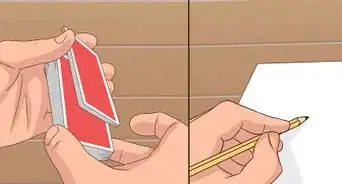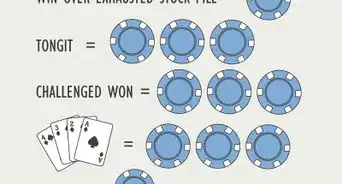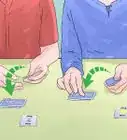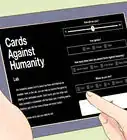This article was co-authored by wikiHow Staff. Our trained team of editors and researchers validate articles for accuracy and comprehensiveness. wikiHow's Content Management Team carefully monitors the work from our editorial staff to ensure that each article is backed by trusted research and meets our high quality standards.
There are 8 references cited in this article, which can be found at the bottom of the page.
wikiHow marks an article as reader-approved once it receives enough positive feedback. In this case, 91% of readers who voted found the article helpful, earning it our reader-approved status.
This article has been viewed 621,642 times.
Learn more...
Apples To Apples is a card game that is appropriate for all ages and is a blast to play in groups. Players have to match red object cards with green descriptive cards, and whoever comes up with the strongest or most amusing pairing wins. You can learn the rules of Apples To Apples in no time at all: simply deal the deck, pick a judge and let the fun begin!
Steps
Printable Rule Sheet
Getting Started
-
1Decide how many players there will be. Get together a group of your friends to play the game. Players should gather around a table or arrange themselves in a circle on the floor. Apples To Apples works best with 4-10 players, but some versions can be played with more. The fewer players there are, the faster paced the game will be, which can increase the hilarity.[1]
- A deluxe “Party” version of Apples To Apples can be played by 12 or more people.[2]
-
2Shuffle the two decks of cards. Start by thoroughly shuffling both the red and green decks of cards to make sure that they are drawn in random order. Cards from each deck will be used during every individual round of play. Keep the decks separated—red cards should never be mixed with green cards within a deck.[3]
- Always make sure to shuffle after the conclusion of a game so that the same cards aren’t dealt and played in the next game.
Advertisement -
3Pick a judge for the first round. Decide among your friends who will serve as the judge for the first round of gameplay. The judge is responsible for deciding who has the best match, and therefore who wins each round. Each player has a chance to be the judge, as the position is handed off to the player on the left after each consecutive round.[4]
- Judges may pick the winning red card for any reason. One judge might choose the strongest direct match, such as a red card reading “Scissors” for a green card reading “Sharp,” while another will favor ironic or humorous associations. These types of differences are what makes the game exciting!
- Everyone will take multiple turns as the judge, so it doesn’t much matter who starts the game off.
-
4Deal seven red cards to each player. The judge will also act as the dealer. Whoever your group chooses to be the judge of the first round will deal seven red cards to each player around the table. You will replenish your red cards after every round, meaning that each player should always have seven red cards at the start of a new round. When each player has seven red cards in their hand, the game is ready to begin.
- Keep an eye on your red cards to make sure you have seven at at all times. Otherwise, you may be limiting your playable options.
Playing and Winning
-
1Turn over the top green card. The judge should flip over the card at the top of the green deck and call it out to the group. Green cards bear descriptive terms that must be matched by the people, objects, places or events on the players’ red cards. The green card in play might read “Cute,” “Harmful” or “Patriotic.” These terms are designed to describe the red cards laid down by players each round.[5]
- There are over 749 red cards and nearly 249 green cards in the basic version of the game. That’s enough different matches for hours and hours of fun.
-
2Lay down a red card to match the green card. Players will now select one of their seven red cards to associate with the word on the green card. For example, a player might play a red card reading “Babies” to match a green card reading “Cute.” There are nearly endless possible combinations of red and green cards, so get creative![6]
- Each player should choose a red card to play quickly to keep the game moving at a brisk pace. Cards should be played face down beside the green card.
- The judge is the only player who will not lay down a red card. The judge changes every round, giving everyone an equal chance to play.
-
3Mix up the stack of cards. After every player has laid down a red card, the judge should shuffle or mix up the stack of red cards in play. This will ensure that the judge doesn’t know who played each card. The cards should be left face down as they are rearranged.[7]
- There’s no need to shuffle extensively. Just reorganize the red cards until they’re out of the order in which they were laid down.
-
4Decide who has the best match. Now the judge will turn over and look at each card. Whichever card the judge decides is the best match for the green card wins. The winning player will identify themselves and collect the green card from the round. The player to the left of the first round judge will become the new judge, players will take one card from the red deck to replenish their hand and the game will continue.
- The number of green cards accumulated by the end of the game determines the winner. The official Apples To Apples rule guide suggests 8, 7, 6, 5 and 4 green cards be the winning number for games with 4, 5, 6, 7 and 8 players, respectively.[8]
- After the round-winning card is chosen, all red cards that have been played should be returned to the bottom of the red deck.
-
5Choose a winning number of green cards. The game’s official rules recommend that players compete for a certain number of green cards in order to win. However, you can modify this number as you see fit. For instance, you might play for 10 green cards to keep the game going longer, or take a “sudden death” approach and see who can win 3 cards the fastest. The options are totally customizable, depending only on the number of players in your group and how you’d like the game to proceed.[9]
- You might also elect for players to replace their red cards with green cards for a winning outcome. For this to work, a player will add the green cards they’ve won to their deck after each round, meaning they’ll have fewer red cards to choose from. Once a player reaches seven green cards in their deck, they are declared the winner.
Changing Up the Game
-
1Match opposites in the “Crab Apple” version. Rather than finding the strongest match for each card, switch gears and play the “Crab Apple” version of the game. This requires players to play red cards that are the opposite of the green card in play. If the green card reads “Scary,” players might try to win the round with cards like “Kitten” or “Love.” Choose carefully—coming up with the right combination of cards might be trickier than you expect![10] [11]
- Playing Crab Apple effectively doubles the number of possible card associations.
- Variant versions of Apples To Apples force you to think more carefully about your card choices, breaking up the monotony of the standard games.
-
2Play “Apple Potpourri.” For a more challenging and hilarious experience, try playing “Apple Potpourri.” This is when players choose a red card to play before the green card is revealed. The judge chooses the best match as usual, but the player gives up control over their card associations and the outcomes are random. Apple Potpourri can be especially fun in large groups, as there will be more options for the judge to choose from.[12] [13]
- Apple Potpourri is a perfect alternative for groups where the judges tend to choose the most entertaining card combinations.
-
3Try “2-For-1 Apples.” To up the stakes of the game and keep things interesting, make each round count double. The judge will turn over two green cards instead of just one, and players will have to choose a red card that is best described by both of the terms on the green cards. This variation of the game forces players to think more carefully about each pay, as red cards has to be associated with two different terms, and rounds are worth two green cards.[14] [15]
- For the 2-For-1 Apples version of the game, you can decide whether the same number of cards is necessary to win, resulting in a quicker paced game, or whether to also double the number of green cards needed and only increase the difficulty of each round.
Community Q&A
-
QuestionCan Apples To Apples be played with only two people?
 Community AnswerUnfortunately no. There needs to be a sufficient number of people to play with one player acting as a judge. The game's official rulebook recommends at least 4 players take part.
Community AnswerUnfortunately no. There needs to be a sufficient number of people to play with one player acting as a judge. The game's official rulebook recommends at least 4 players take part. -
QuestionWhat do you do with blank cards?
 Community AnswerYou can fill in a blank card with any word of your choosing (just keep it appropriate). It's entirely up to you.
Community AnswerYou can fill in a blank card with any word of your choosing (just keep it appropriate). It's entirely up to you. -
QuestionCan I change the rules?
 Community AnswerSure! Make any adjustments to the game you like. Just make sure the rules still make sense. One of the best parts of Apples To Apples is that it can be customized in so many different ways, and stays fun game after game.
Community AnswerSure! Make any adjustments to the game you like. Just make sure the rules still make sense. One of the best parts of Apples To Apples is that it can be customized in so many different ways, and stays fun game after game.
References
- ↑ https://www.fgbradleys.com/rules/ApplesToApples.pdf
- ↑ http://www.com-www.com/applestoapples/applestoapples-rules-official-partyset.html
- ↑ https://www.fgbradleys.com/rules/ApplesToApples.pdf
- ↑ https://www.fgbradleys.com/rules/ApplesToApples.pdf
- ↑ https://www.wordnik.com/lists/apples-to-apples--green-cards
- ↑ https://www.wordnik.com/lists/apples-to-apples--red-cards
- ↑ http://www.com-www.com/applestoapples/applestoapples-rules-official-basicset.html
- ↑ https://www.fgbradleys.com/rules/ApplesToApples.pdf
- ↑ http://www.com-www.com/applestoapples/applestoapples-rules-official-basicset.html
- ↑ https://www.fgbradleys.com/rules/ApplesToApples.pdf
- ↑ http://www.com-www.com/applestoapples/applestoapples-rules-variations-03.html
- ↑ https://www.fgbradleys.com/rules/ApplesToApples.pdf
- ↑ http://www.com-www.com/applestoapples/applestoapples-rules-variations-05.html
- ↑ https://www.fgbradleys.com/rules/ApplesToApples.pdf
- ↑ http://www.com-www.com/applestoapples/applestoapples-rules-variations-06.html
About This Article
To play Apples to Apples, you’ll need 4-10 players. Your game should include a deck of red apple cards that each have a person, place, thing, or event on them, as well as a deck of green apple cards that each have a characteristic of a person, place, thing, or event on them. Choose one player to be the first judge. The judge deals 7 red apple cards face-down to each player (including themselves) and places a green apple card face up on the table. Then, all of the players except for the judge choose a red apple card from their hand that is best described by the face-up green apple card. For example, if the green apple card is “Scary,” players might choose “Monster,” “Spider,” or “Halloween.” Each player gives their chosen red apple card face-down to the judge, who then shuffles the cards and reads them out loud. The judge chooses which red apple card they think fits best with the green apple card. They can choose based on any reasoning they’d like, and players are able to convince the judge of their favorite before the judge makes their final selection. Once the judge has chosen, the player who played that card wins the round and receives the green apple card. All of the played red apple cards are discarded and a new judge starts the next round. Each player should draw a new red apple card if needed so they have 7 cards in their hand. The game continues until a player has acquired enough green apple cards to win. For a 4-player game, the first player to earn 8 green apple cards wins. In a 5-player game, it’s 7 green apple cards. A 6-player game requires 6 green apple cards, a 7-player game requires 5, and an 8-10 player game requires 4. To learn how to mix the game up to keep it interesting, read more!
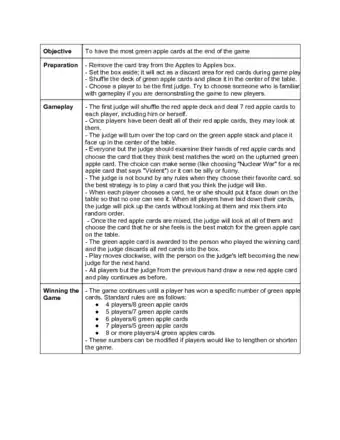

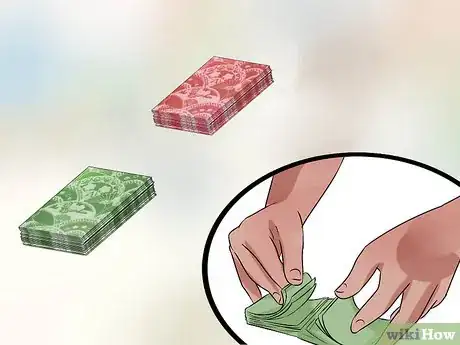

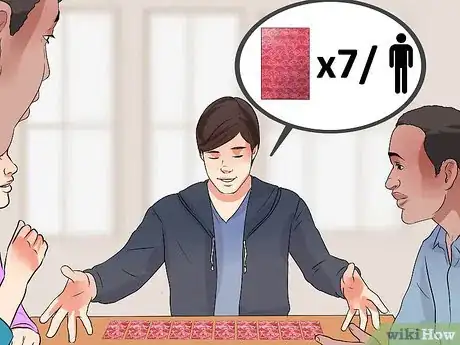
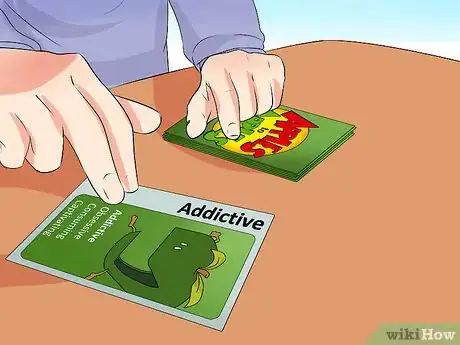
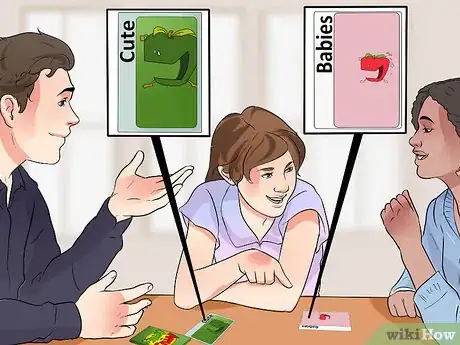
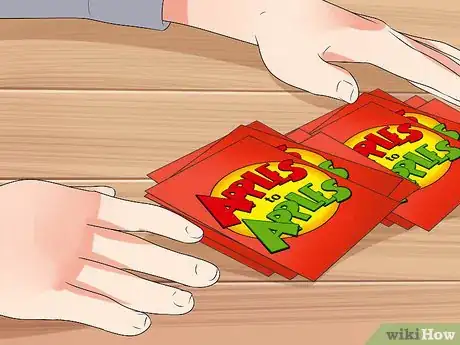


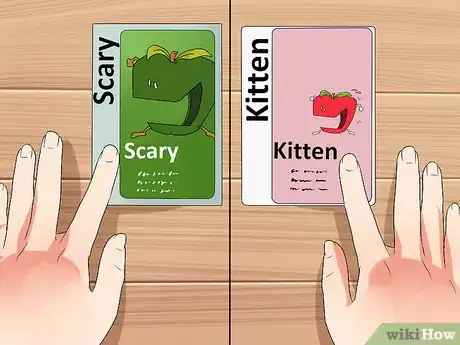

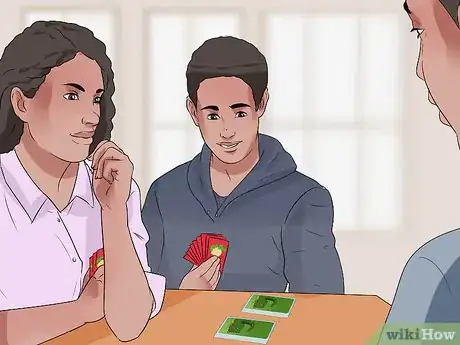
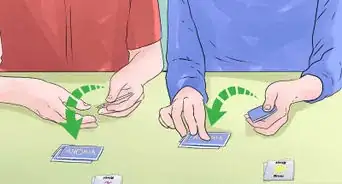





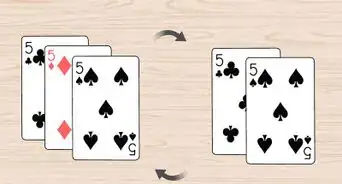
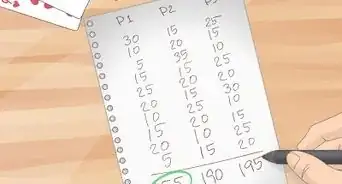


-Step-17.webp)
